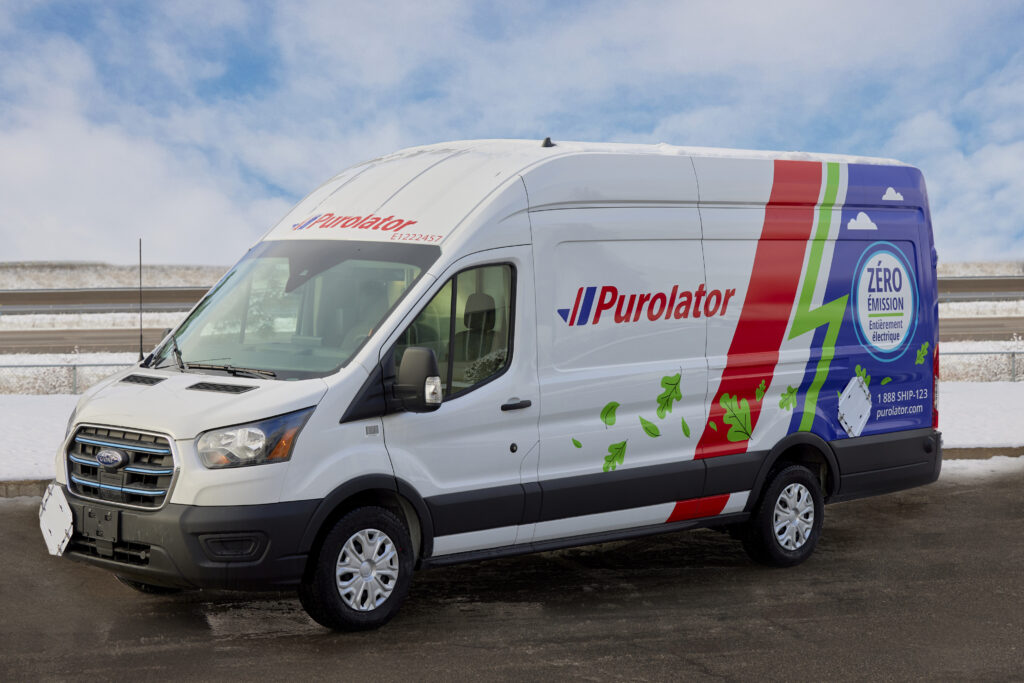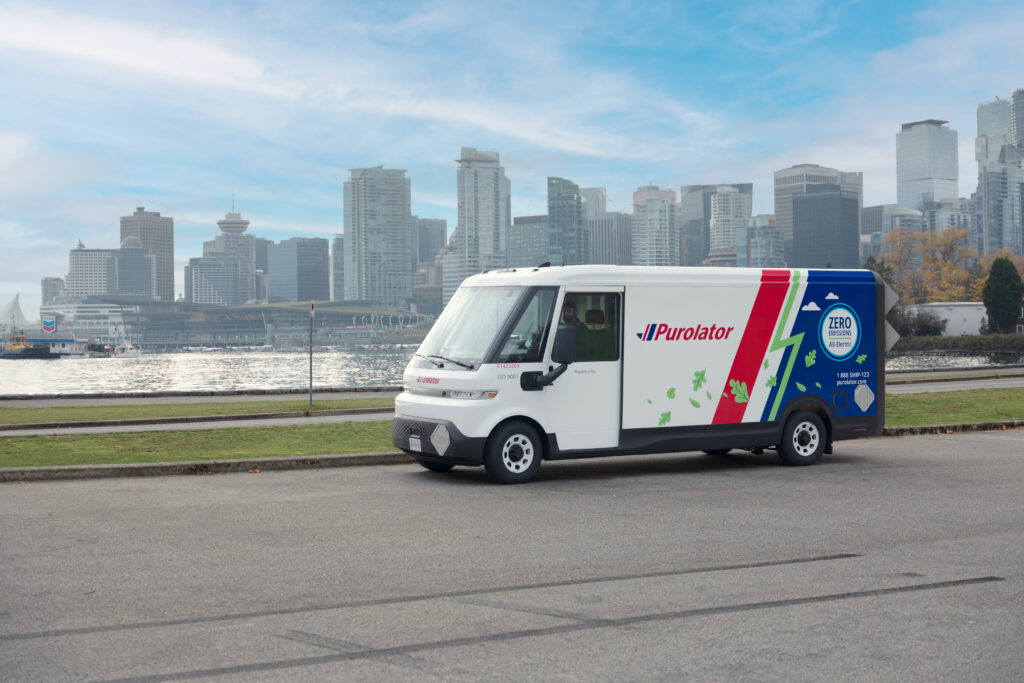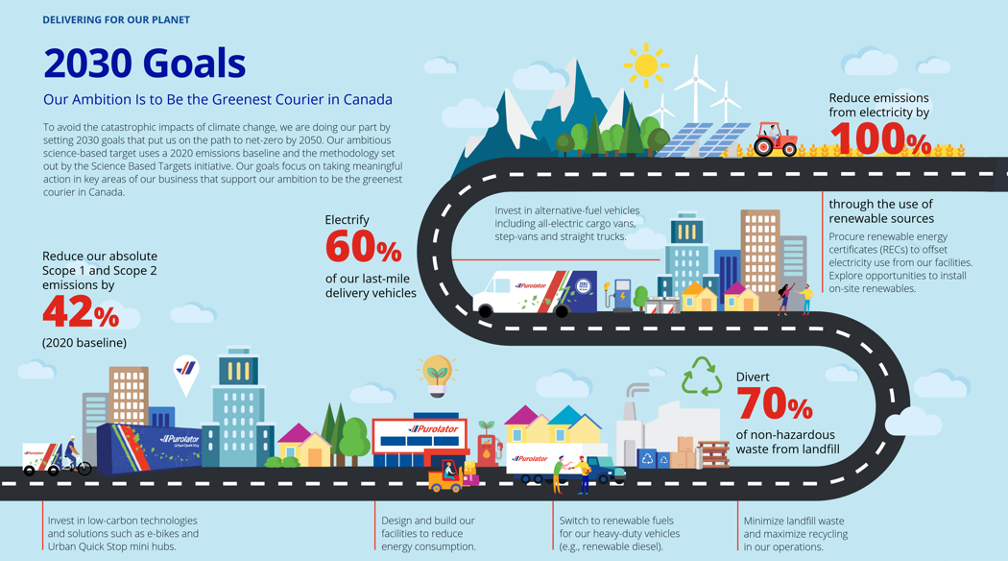The Road to Emissions Reduction
Cindy Bailey, Corporate Sustainability Officer at Purolator, emphasizes the need for businesses to create climate action plans aligned with a net-zero pathway. The article focuses on the importance of transparency, stakeholder engagement, and adoption of emissions reduction plans in response to evolving factors.
Purolator began its journey to reduce emissions in 2005, when we introduced more than 500 hybrid-electric vehicles into our operations. At that time, we understood we had a responsibility to do better for the environment, and our focus on innovation drove us to try new things. While Purolator, and many other organizations, made these sorts of early efforts to green our business, we have all faced escalating pressure in recent years from a broad range of stakeholders. The time has come to deliver material emissions reductions that align with a net-zero pathway, and to do so in a focused, transparent and efficient way.
The science published in recent years, including the 2023 IPCC Report, clearly shows that human-induced global warming has spurred changes to the Earth’s climate that are unprecedented in recent human history. Urgent, systemwide transformations are needed to secure a net-zero, climate-resilient future.
Where to begin? Baselines and goal setting
With this in mind, Purolator knew we needed to deliver a strong climate-action plan that delivers for the planet, our people, our customers and our communities. Where to begin? Well, first we needed to understand our emissions. As the saying goes, “you can’t manage what you don’t measure.” So as an organization begins developing a plan and setting goals, the first step is to identify all emissions sources and measure these emissions as accurately as possible. Those of us who have done this know that this task is a journey, and the data will evolve and improve over time.

Second, as emissions are calculated and an inventory is developed, it’s important to follow a credible emissions accounting standard, such as the GHG Protocol. The GHG Protocol provides a global, comprehensive, standardized framework to help all types of organizations measure and manage their GHG emissions.
Finally, after you’ve measured your emissions and organized them into a comprehensive inventory, it’s good practice to have another set of eyes review and validate the accuracy of your work. Verification by a third-party auditor provides the required credibility and transparency.
Knowing where all your emissions come from is very liberating, and sometimes what you uncover might be surprising. Also, a strong baseline emissions inventory gives you the power to set actionable goals and create the roadmap that will set you up to achieve them. Setting science-based goals shows you how ambitious you need to be to align your business with a net-zero emissions reduction pathway.
“A strong baseline emissions inventory gives you the power to set actionable goals and create the roadmap that will set you up to achieve them”
Cindy Bailey
The Science Based Targets initiative (SBTi) provides a framework for setting both long-term and interim goals. Working with SBTi, you can set interim goals for your Scope 1, Scope 2 and Scope 3 emissions and identify the most important areas to focus your actions. This is the first step in preparing your strategy and a detailed roadmap. To ensure transparency, it’s also important to publish your roadmap and supporting goals; this can be accomplished through an annual sustainability report or similar publication.
Building engagement and making changes
Once goals are set, work with leaders across your organization to identify the most practical ways to reduce emissions in your business and align these actions with the scale of implementation required to achieve your interim goals. For many companies, meeting these goals will require significant operational changes that must be supported and implemented by employees and stakeholders across the business. The key to success is early engagement with business leaders to create and sustain organizational buy-in, while developing an emissions reduction roadmap together. It is important that senior leadership is aligned with the chosen level of ambition and the supporting work plan, resources and investments required to execute.
Companies will often begin by looking at their Scope 1 and 2 emissions, as these are sources within their direct control, and it is often easier to achieve quick wins and see results when implementing initiatives focused on direct emissions. Through the use of renewable electricity, alternative-fuel vehicles and energy efficiency in buildings, meaningful reductions can be generated in Scope 1 and 2 emissions. But for most companies, Scope 3 emissions, which are derived from an organization’s value chain, tend to make up more than 70 percent of their total emissions. For this reason, net-zero emissions cannot be achieved without tackling the “dreaded” Scope 3 emissions. These emissions may offer the greatest potential for emissions reduction, but they also bring the greatest challenges.
“Net-zero emissions cannot be achieved without tackling the “dreaded” Scope 3 emissions”
Cindy Bailey

To reduce Scope 3 emissions, companies must align their values and objectives with like-minded employees, suppliers and customers. This means instituting a culture and policies that support sustainable procurement of good and services, partnering with vendors with shared goals and encouraging employee behaviours that drive emissions reduction.
Collaboration is key
To achieve our goals, we cannot act alone. We must find ways to collaborate and partner with our industry peers, government, suppliers, customers and our communities. By working together, we improve innovation through diverse skills, perspectives and experiences. Collectively, we bring a stronger voice to the table, and we increase our impact by pooling resources and expertise.
As you develop your goals and roadmap, reach out to your stakeholders and look for opportunities that benefit both parties. Communicate your priorities and expectations, and plan together so that everyone has sufficient time to prepare and deliver results.
Look for networks that can support you along the way. Several years ago, Purolator joined the Pembina Urban Delivery Solutions Initiative, a national network of businesses and organizations working together to reduce freight emissions in Canada. Through these types of networks, companies can collaborate to achieve their shared goals.
Finally, remember that your emissions reduction plans will continue to evolve with time. As the market and your business changes, technologies emerge and evolve and data becomes more accurate, you will need to revise your roadmaps accordingly. That said, be transparent with your stakeholders by sharing performance data often and keeping them informed of changes to your strategy.

To summarize, it’s important to get started. Understand and measure your emissions sources and have them third-party verified. Engage your senior leadership early to create buy-in across the organization and agree on the level of ambition for your business. Set interim goals and work with all your stakeholders to create a roadmap that is aligned. Prioritize your initiatives and identify the short- and medium-term opportunities to reduce emissions. And as you move forward, most importantly, hang in there. It won’t be easy, but together we can make an impact and preserve our planet for future generations.














